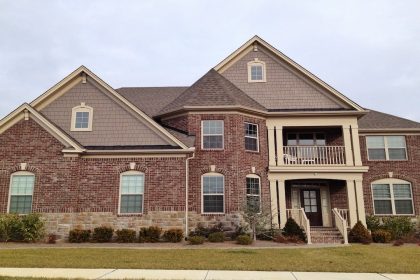MoMo Productions/GettyImages; Illustration by Hunter Newton/Bankrate
Key takeaways
- Downsizing involves moving out of your current home to a smaller, ideally less expensive property.
- The most common reasons to downsize include saving money, needing less space and wanting a home that better fits current mobility needs.
- If you plan to downsize to save money, compare all the costs of your current home, including the mortgage, property taxes, utilities and maintenance, with the cost of moving to and paying for a new home.
Downsizing is the process of moving from a larger home to a smaller one, often one that costs less in upkeep. This might mean moving from a detached, single-family property to a condo or townhome, or to an assisted living facility or retirement community. For some, it might involve moving into an accessory dwelling unit, or ADU, on a family member or friend’s property.
Rather than downsizing, some homeowners also opt to “rightsize,” or move to a home that better fits their needs in the future, regardless of size or cost. This could mean moving from a home with two stories to a home with one or moving from a rural home to one in a city or suburb.
Either way, moving can be an emotional process — especially if you’re leaving a home where you’ve lived for many years. And if you’re doing it for financial reasons, you’ll want to be sure the house you’re buying actually saves you money. Here’s what to know.
Why should you downsize?
There are many reasons to downsize, including:
- Economic necessity: Many older adults face costs, such as rising medical expenses and home insurance premiums, on fixed incomes. For some, it’s financially practical to sell their current home and move into a smaller, less expensive one.
- Retirement: Fifty-seven percent of American workers feel behind on their retirement savings, according to a 2024 Bankrate survey. Downsizing before or during retirement can help you stretch your savings. You can also bank any proceeds remaining after buying your new, smaller home.
- Convenience: You’re not alone if you’re tired of doing all the housework and maintenance for a larger home. Many downsizers switch to smaller homes where the upkeep is less expensive and taxing.
- Health concerns: Many seniors downsize — or rightsize — to a home with fewer everyday obstacles, such as stairs. Some move closer to hospitals or other medical services, and others prioritize access to public transit, especially if driving has become an issue. Others choose to live closer to family or friends.
- Seller’s market: Some downsizers simply seek to take advantage of a seller’s market. If you’ve been living in your current home for a while, you might be able to walk away with a good chunk of change, enabling you to buy a smaller home in cash.
What to consider when downsizing
If you’re downsizing for financial reasons, it’s important to ensure you’ll actually come out ahead after selling your home and buying a new one.
“The financial benefit of downsizing in retirement typically results when going from a large mortgage to a small mortgage, or from a small mortgage to no mortgage at all,” says Greg McBride, chief financial analyst for Bankrate. “If you have substantial equity in your existing home, downsizing can mean taking that equity when the home is sold and using it to pay cash or make a large down payment on a lower-priced home, reducing your monthly living expenses.”
Here’s what to consider.
What are you paying now? What will you pay for a downsized home?
Make a list of all the expenses associated with your current home, plus anything else you pay related to housing on a monthly basis. Compare those figures with what you’ll pay for your next place. If you still expect to take out a mortgage when you move, you can estimate the monthly payment with Bankate’s mortgage calculator.
If you plan to move to a neighborhood with a homeowners association, find out the monthly fees and include those in your estimates as well.
What’s your current financial situation?
If you’re downsizing pre-retirement, you want to make sure your new home is affordable now and in the future. That involves taking a holistic look at your finances, keeping your housing costs in mind. Think about:
Map out different scenarios based on your expected longevity and worst-case scenarios, as this affects how much you’ll have to live on.
What will it cost to sell your home and buy another?
As the seller, you’ll need to pay for expenses like home repairs and closing costs, including transfer taxes in some states. You might also be on the hook for a real estate agent commission. Then you’ll need to pay buyer’s closing costs, such as attorney fees and title insurance, when you purchase your new home.
Keep in mind that homes are much more expensive today. The smaller home that you hope will save money might actually cost more than your current home.
“It is easy to downsize in terms of space, but downsizing in cost may not be as simple,” McBride says. “If you’ve been in your current home a long time, the smaller place you look to downsize to may be selling for more than you’d originally purchased your existing home. You don’t want to go from a small mortgage to a larger one or from no mortgage to now having a monthly mortgage payment.”
The best states to retire are Delaware, West Virginia and Georgia, according to a 2024 Bankrate study. The worst are Alaska, New York and Washington.
How to downsize your home
Downsizing — or rightsizing — is similar to selling a home and buying a new one in any other circumstances. You’ll list your current home, while figuring out what you can afford on a new one, looking for a house that meets your needs and applying for a mortgage, if necessary.
If you’ve retired, however, and you need a mortgage, the process may look slightly different than it did when you were working. You’ll want to:
- Give yourself a financial check-up. Whether you’re working or not, a lender will want your credit score and debt-to-income (DTI) ratio to meet its requirements. If you’ve frozen your credit as a precaution against fraud, you’ll need to temporarily lift the freeze.
- Consider different mortgage types. While your previous mortgage may have been conventional, another type may be a better fit for you now. For example, you may want a bank statement loan, which lets you qualify for a mortgage using bank statements rather than tax returns or W-2s.
- Gather your documentation. Whatever type of mortgage you pick, you’ll need to prove to your lender that you can afford it. Find out the paperwork you need and assemble it ahead of time to help your application process go smoothly.
- Find the right agent. You may benefit from an agent who specializes in the needs of older adults. Ask friends and family or local senior services organizations for referrals.
Tips for downsizing
- If you’re moving to a new location, do your homework. If you plan to downsize out of state, take a trip or two to visit the new location and learn what it’s like to live there. Consider its cost of living for expenses like healthcare, utilities and groceries, as well as quality of life factors, like weather and opportunities for recreation. If you plan to move to a retirement community, ask neighbors what they like or dislike about the area.
- Get organized. Start clearing out clutter and packing boxes. Decide whether to keep, donate, sell or toss items. If you find this overwhelming, ask a trusted family member or friend to help you sort through your home. Professionals can also help with this task.
- Start living on less now. If possible, begin cutting your spending ahead of downsizing. This can make the transition to lower-cost living easier when you move.
FAQ
Read the full article here
















